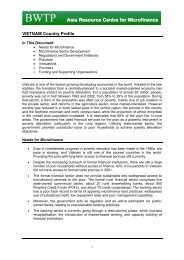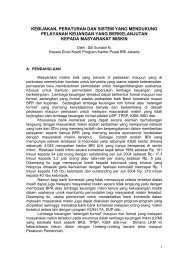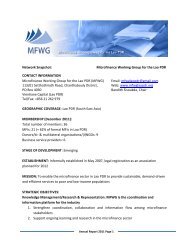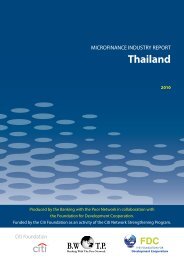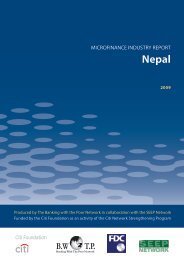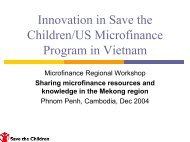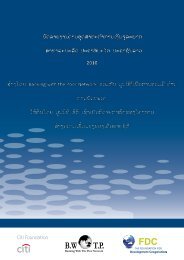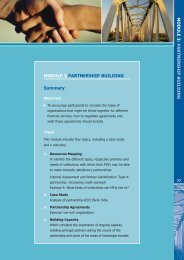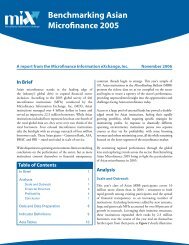Microfinance Industry Report: Indonesia - Banking with the Poor ...
Microfinance Industry Report: Indonesia - Banking with the Poor ...
Microfinance Industry Report: Indonesia - Banking with the Poor ...
Create successful ePaper yourself
Turn your PDF publications into a flip-book with our unique Google optimized e-Paper software.
At <strong>the</strong> end of September 2004, BRI had 87% of its loan<br />
portfolio in micro, small and medium enterprises,<br />
while corporate lending represented <strong>the</strong> remaining<br />
13%. Some 31% of <strong>the</strong> Rp.58,119 billions (US$6.2<br />
billions) in loans outstanding were related to <strong>the</strong><br />
microenterprise sector, or Rp. 18,146 billions (US$1.9<br />
billion).<br />
The success of private lender Bank Danamon<br />
in microfinance lending has stimulated o<strong>the</strong>r<br />
commercial banks, such as BTPN , Bank Mega<br />
Syariah, Bank Mayapada, Bank NISP and Bank DIPO<br />
International, all of which are ‘down-scaling’ <strong>the</strong>ir<br />
operations to enter <strong>the</strong> microfinance sector. Prior<br />
to <strong>the</strong> current financial crisis, a state bank, BTPN<br />
(Bank Tabungan Pensiunan Nasional), <strong>with</strong> support<br />
from Texas Pacific Group (TPG), had signalled an<br />
investment of some Rp. 30-40 trillion in <strong>the</strong> next 5<br />
years for microfinance operations. Bank Mega Syariah<br />
was programming 210 microfinance outlets in 17<br />
cities. It is <strong>the</strong> pioneer among Islamic banks in <strong>the</strong><br />
sector. Bank Mandiri, <strong>the</strong> biggest Commercial Bank<br />
in <strong>Indonesia</strong>, had announced its intention to open<br />
300 new Microbanking units and to recruit 1,700<br />
employees for <strong>the</strong> purpose in 2008. It was planning<br />
to increase microfinance lending to more than 10%<br />
of its portfolio.<br />
It is important to distinguish between <strong>Indonesia</strong>n<br />
banks engaged in micro-financing for strictly<br />
commercial reasons and those engaged by reason<br />
of a social mandate or in response to government<br />
suasion and regulation. This is not simply a matter<br />
of state ownership as against private enterprise;<br />
thus Bank BRI still has majority state ownership<br />
but pursues a strictly commercial agenda. Bank<br />
Mandiri is a state bank whose agenda includes both<br />
a ‘social mission’ and commercial considerations.<br />
Bank Danamon, a listed public company, is one<br />
of a number of private commercial banks alive<br />
to <strong>the</strong> commercial possibilities of microfinance<br />
and actively committing resources to <strong>the</strong> field.<br />
O<strong>the</strong>r private banks feel it necessary to find an<br />
accommodation <strong>with</strong> government and/or central<br />
bank suasion and requirements. Thus (<strong>with</strong> varying<br />
degrees of enthusiasm) <strong>the</strong>y employ some assets<br />
in microfinance, ei<strong>the</strong>r directly or through linkages<br />
<strong>with</strong> smaller regulated financial institutions (BPRs).<br />
The BPRs <strong>the</strong>mselves vary in regard to <strong>the</strong>ir interest<br />
in and capacity for micro-lending. Those owned by<br />
local governments and cooperatives are often more<br />
micro-oriented, while those under private, for-profit,<br />
ownership are often more focused on small and<br />
medium-sized enterprises. The BPRs are discussed in<br />
greater detail below.<br />
In addition, most formal financial providers<br />
(commercial banks and BPRs) also operate specific<br />
units, branches and products using Syariah (Islamic)<br />
banking principles. Islamic banking is a significant<br />
force in <strong>the</strong> microfinance and financial sectors in<br />
<strong>Indonesia</strong>, in terms of volume of financial services<br />
provided and <strong>the</strong> number of outlets providing<br />
<strong>the</strong>m.<br />
All banks are aware of Bank BRI’s success in financing<br />
its lending through savings mobilization, although<br />
most are not in a position to compete <strong>with</strong> it by<br />
reason of <strong>the</strong> restricted range of <strong>the</strong>ir branch<br />
networks. It is true that banks o<strong>the</strong>r than BRI<br />
face daunting establishment costs in expanding<br />
outreach. Bank BRI’s rural network is <strong>the</strong> legacy of<br />
substantial government investment, much of it done<br />
before <strong>the</strong> 1980s, when commercial criteria were<br />
not so important. But <strong>the</strong> long recovery from <strong>the</strong><br />
1997 financial crisis, during which loan to deposit<br />
ratios were low, had also diminished incentives for<br />
commercial banks to open new branches to mobilise<br />
savings. More widespread competition for deposits,<br />
including those of <strong>the</strong> poor, must await a time<br />
when commercial bank lending becomes liquidityconstrained<br />
due to economic growth. This is not<br />
an early prospect under <strong>the</strong> financial conditions of<br />
2008.<br />
12 microfinance industry report - INDONESIA<br />
<strong>Indonesia</strong>_<strong>Report</strong>_forprint.indd 12<br />
27/05/2009 3:14:42 PM



